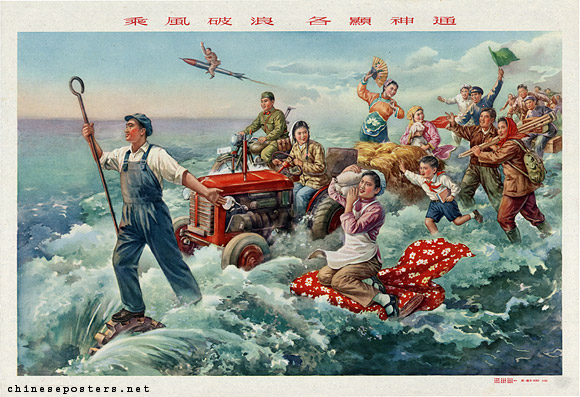Five Year Plans
Understanding the Banqiao Dam failure in 1975 requires understanding the context of the Dam’s construction in 1951. During the 1950s, newly communist China embarked on its first two Five Year Plans, under the vision of Chairman Mao. After Mao and the Communist party took power in 1949 they started by granting land to the numerous peasants across China and trying to organize the massive and complex region that was China at the time (SJSU).
As part of this vision, China embarked on its first two Five Year Plans in the 1950s. These plans, known as the Great Leap Forward, attempted to “transform China from a backward agricultural country into a powerful industrial economy.” (Rosse) Mao’s vision was for a collectivized, preposterous, and flourishing China with a preeminent industry powered by a strong and highly organized agricultural base.

Dam Construction
Soviet engineers and foreign aid greatly assisted these early years of Chinese industrialization (Watkins). Dams were a particularly important part of the Five Year Plans. They contributed to Mao’s vision in multiple ways. Many of China’s river valleys, the most fertile regions, experienced periods of flooding which disrupted the regularity desired by collectivized agriculture. Dams could carefully control flood and retain water. Dams provided a symbolic feature of industrialized society, a huge structure showing that “man could conquer nature” (Smith). Some dams also provided hydroelectric power to serve China’s emerging electricity needs.

The Banqiao Dam was one of the first dam projects under this new developmental framework, built in 1951. It was completed with “fairly rigorous technical specification” and deemed unbreakable (Human Rights Watch). With early success, Communist party officials all the way up to Mao viewed “water storage as the key link” to collectivized agriculture and industrialization (HRW). They constructed over a hundred dams in the Henan region, and many more elsewhere as well (HRW). In light of the initial successes of the Banqiao dam, the Chinese government did not take the steps to develop the reason responsibly with dams. Flood mitigation measures were not constructed and the confined Huai river valley became oversaturated with dams and reservoirs (HRW).
Failure and Famine
This reckless development continued across China’s Five Year Plan. In order to supply their insatiable desire for industrial development, the government pulled peasants away from agriculture to work in “backyard blast furnaces” and building projects (Watkins). This diversion of labor and low crop yields from overplanted fields led to food shortages in the late 1950s (Watkins). This period became known as the Great Chinese Famine, and potentially over 30 million people died (Watkins).

The famine provides another example of a disaster caused by reckless development plans and a single minded central government. The Chinese government also tried to cover up and shift blame away from systemic failures in the case of the famine. Sadly, this pattern of development, denial, and disaster repeated again in 1975 with the horrible dam failure.